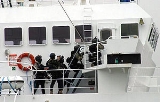
and/or special operations forces units, specializing in amphibious landings
, parachuting
, rappelling and similar techniques, to conduct and effect attacks. Originally "a commando" was a type of combat unit, as opposed to an individual in that unit. In other languages, commando and kommando denote a "command
", including the sense of a military unit.
In the militaries of most countries, commandos are distinctive in that they specialize in assault on conventional military targets.
[Fighting Cooke] I eat green berets for breakfast and right now, I'm very hungry!![]()
All that matters to me now is Jenny.![]()
[Before fighting Bennett] C'mon, Bennett, let's party!![]()
[After throwing a pipe through him with steam coming out of it] Let off some steam, Bennett.![]()
[Cooke says, "Fuck you, asshole", but discovers his gun is empty] Fuck you, asshole.![]()
You're a funny guy, Sully. I like you. That's why I'm going to kill you last.![]()
[Dangling Sully over the cliff] Listen, your loyalty is very touching but it isn't the most important thing right in your life now. But what is important is GRAVITY!![]()
[Dangling Sully over the cliff] And I got to remind you, Sully: This is my weak arm!![]()
[Dangling Sully over the cliff] Remember, Sully, when I promised to kill you last? I lied. [drops Sully]![]()
[After breaking the man's neck on the plane] ...And please do me a favour - don't disturb my friend. He is dead tired.![]()

